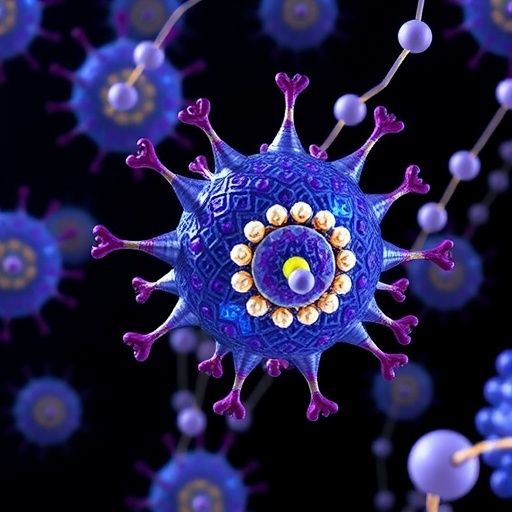In a groundbreaking development within the field of structural biology, a research team led by Professor Dang Shangyu from the Hong Kong University of Science and Technology (HKUST) has created a revolutionary vesicle-based method for studying membrane proteins. These proteins, which play critical roles in various biological functions, have been notoriously difficult to study due to the limitations of traditional detergent extraction methods. This novel technique not only preserves the native lipid environment essential for membrane protein functionality but also enhances structural studies significantly.
For decades, scientists have relied predominantly on detergent-based techniques to extract membrane proteins from cell membranes. While these methods have advanced our understanding to a considerable extent, they are not without significant drawbacks. Detergents can disrupt the natural state of membrane proteins by removing essential lipids, which are crucial for their proper functioning. This extraction process often results in suboptimal conditions for studying the proteins, leading to incomplete or misleading data regarding their structure and function.
Recognizing these challenges, Professor Dang and his research team embarked on a four-year systematic investigation to develop a more efficient and effective method for membrane protein extraction and analysis. By employing innovative techniques, they succeeded in generating vesicles that encapsulate membrane proteins directly from their native cell membranes. This vesicle-based approach eliminates the need for detergents, allowing for a more authentic representation of the proteins in their natural environment.
In their rigorous studies, the team established a comprehensive workflow designed to prepare, purify, and control the quality of the vesicle samples. This method’s versatility holds immense promise for investigating various membrane systems, expanding the scope of research possibilities. In addition, they integrated an artificial intelligence model with a micrograph-based sorting technique to specifically isolate high-quality membrane protein particles, effectively addressing the background signals that often hinder clarity in structural analysis.
The practical applications of this revolutionary method were quickly demonstrated. The team successfully resolved the structure of the overexpressed AcrB protein present in Escherichia coli cell membranes at an impressive resolution of 3.9 Å. Furthermore, they elucidated the structure of the respiratory chain complex III found in porcine heart mitochondrial inner membranes, achieving a remarkable resolution of 3.0 Å. These findings not only underscore the method’s efficacy but also highlight its potential to substantially advance the field of cryo-electron microscopy.
Liu Hang, a Ph.D. candidate and the first author of the study, emphasized the importance of this research, stating, “Leveraging Prof. Dang’s multidisciplinary approach, our team has successfully developed a comprehensive system for in-situ structural studies of membrane proteins.” This assertion reflects the rigorous effort taken to overcome previously insurmountable obstacles in membrane protein research, which for years have stymied scientists’ ability to fully decipher the complexities of membrane biology.
One of the most significant advantages of this vesicle-based approach is its cost-effectiveness and simplicity. Traditional detergent extraction methods often require extensive resource allocation and complicated procedures. In contrast, Professor Dang’s innovative technique streamlines the process, making it more accessible to researchers across various disciplines. By maintaining the natural conformation of membrane proteins as closely as possible, this method promises to yield more accurate and biologically relevant results, paving the way for more in-depth studies of membrane dynamics and their implications in disease states.
Prof. Dang poignantly remarked on the implications of their work, stating, “This vesicle-based platform preserves physiological lipid environments while eliminating the burdens of detergent screening. It provides an opportunity to study membrane proteins in their native environments.” He expressed optimism regarding future optimizations, which could facilitate structural proteomics of membrane proteins in specific biological membrane systems, such as mitochondria. This research is especially pertinent given the increasing recognition of the critical roles that membrane proteins play in various diseases, underscoring the potential to offer valuable insights that could inform therapeutic strategies.
The implications of this research extend beyond mere structural elucidation; they could significantly impact drug discovery and development processes. Membrane proteins are often the targets of pharmaceuticals due to their role in numerous signaling pathways and physiological processes. By advancing the ability to study these proteins in their native environments, researchers may identify new therapeutic targets or improve existing drug efficacy, eventually leading to better health outcomes for patients.
Moreover, as the method demonstrates versatility across different membrane proteins from various species and cellular structures, it holds the promise of broadening the scope of cryo-electron microscopy as a tool for structural biology. This methodology could enable researchers to explore previously understudied membrane proteins, contributing to a deeper understanding of a myriad of biological processes and potentially uncovering novel biological mechanisms linked to health and disease.
Published in the prestigious Proceedings of the National Academy of Sciences, this research has garnered significant attention as it propels the field of membrane protein research into a new era. With Professor Dang as the corresponding author and Liu Hang leading as the first author alongside undergraduate researcher Tse Chun Mong, the study not only exemplifies the spirit of innovation and collaboration in scientific research but also illustrates the critical pathway toward bridging gaps in understanding membrane biology.
This seminal work on vesicle-based studies punctuates the ongoing evolution of methodologies in the biological sciences, reminding researchers of the importance of adaptability and creativity in overcoming longstanding scientific challenges. As the world of structural biology continues to expand, this new approach heralds exciting possibilities for future discoveries that can profoundly impact our understanding of life at the molecular level.
Subject of Research: Cells
Article Title: Capturing the native structure of membrane proteins using vesicles
News Publication Date: 3-Sep-2025
Web References: Proceedings of the National Academy of Sciences
References: DOI 10.1073/pnas.2423407122
Image Credits: Credit: HKUST
Keywords
Life sciences




